U2
 |
 |

|
Under The Joshua Tree Lurked a Psychotic Stalker
by David Chirko
Affiliate Member, American Psychological Association
(June 2021)
The Rock Band & Album
"In 19761, four Dublin schoolboys started the band that, under the name U22, would dominate rock music...." (Erlewine, 1997, p. 393): Bono Vox3 (Paul Hewson) - vocals, guitar; The Edge4 (David Evans) - guitar, keyboards, vocals; Adam Clayton - bass; and Larry Mullen Jr. - drums (Romanowski & George-Warren, 1995, p. 1033). This same roster was inducted into the Rock'n'Roll Hall of Fame in 2005 (Morse, 2005, p. C2). Rock scribe Hugh Wilson (1996) says that, although they garnered world renown, "...the passion of their...fans is matched by the...contempt of...[their] detractors" (p. 925). He believes that they have been, perhaps deservedly, panned for their apparent grandiloquence. However, Wilson also avers U2 attained their apex with what has been touted as one of the quintessential rock albums of the '80s: the Daniel Lanois and Brian Eno produced, March, 1987 release of The Joshua Tree. The album was named after a desert area and tree in Yucca Valley, California (The Mojo on The Mojave, 2014). There, in 1973, deceased former Byrds member Gram Parsons was cremated by his road manager, Phil Kaufman, to fulfill a pact they had (Rogan, 2017, pp. 778-9). U2 "...well knew of the story of Gram Parsons and how he died..." (The Mojo on The Mojave, 2014). Moreover, after visiting Joshua Tree National Monument, U2 had photos snapped by the iconic tree for their album cover. Bono remarked, "We loved the landscapes we were travelling through. This mythic America, I think we were all lost to" (Doyle, 2017, p. 77).
Indeed, with U2 one "...felt a sense of indigenous Irish music blending with American folk music" (McCormick, 2006, p. 172). The Joshua Tree album, Wilson (1996) further says, is where the sonic superseded the ariose and phraseology trumped content, as the post-punk tracks, poetic or political, revealed an uncanny refinement. Also, following the release, U2 was feted on the front cover of Time magazine (p. 927). They were also featured on the cover of Rolling Stone, again. Colin Larkin (1998), in his Virgin all-time top 1000 albums, rates The Joshua Tree at Number 18. Larkin found, in contradistinction to some of what Wilson stated, that "The pure power of the music and patent honesty of the lyrics steer the band clear of whimsy and self-indulgence" (p. 22). U2 was awarded Best Rock Performance By a Duo Or Group with Vocal, and Album of the Year, honors at the 1988 Grammy Awards for The Joshua Tree, which then became the fastest selling British album ever and the quickest in the U.S., too (Grow, 2017). The Joshua Tree went platinum in 48 hours and entered the U.K. chart at Number 1, also topping the charts in the U.S., Canada and Ireland. It yielded the worldwide hits "With Or Without You" (Number 1 in the U.S., Canada and Ireland), "I Still Haven't Found What I'm Looking For" (Number 1 in the U.S. and Ireland), and "Where the Streets Have No Name" (Number 1 in Ireland). U2 performed, unexpectedly, the last mentioned song live for a video on March 27, 1987, from a downtown Los Angeles rooftop (Rees & Crampton, 1991, p. 540)--just like the Jefferson Airplane did with "The House at Pooneil Corners," November [19], 1968, from a downtown New York City rooftop (Tamarkin, 2003, pp. 180-1).
For the purpose of this exposition, the most significant song on The Joshua Tree album is a cut called "Exit," which I will later discuss at length later.
The U2 Devotee: Robert Bardo
Natalie DeGroot (2019, November 26) relates how Robert John Bardo (January 2, 1970- ), from Tucson, Arizona, where he lived since he was 13, was the youngest in a peripatetic family of seven. His alcoholic father, mentally ill mother, and abusive older brother were all neglectful of him. In junior high school Robert excelled academically. However, a teacher noted how potentially explosive he was, after espying letters Bardo circulated describing his fixation on murder and his own suicide. The school thus recommended psychiatric care for him to his parents, who had him undergo but a few counselling sessions.
Further, DeGroot notes that, in high school, Bardo continued to achieve good marks, but a teacher commented on how volatile his behavior could be. He was placed in foster care, and then in a psychiatric hospital for a month during the summer of 1985. The psychiatric evaluation concluded that Bardo's family was "pathological and dysfunctional." As for Robert, they pronounced him "severely emotionally handicapped" and diagnosed him with bipolar disorder5. Bardo became a grade nine dropout, later engaging in menial labor and interacting with few people. Forensic psychologists Louis B. Schlesinger, Ph.D., and V. Blair Mesa, M.A. (2008), present a similar portrait of Bardo, but add that his "...early life was marked by...school failure, few friendships, either male or female" (p. 84). YouTube commentator Pannoni14 (2020) asserts that his father asseverated later in court, when Robert was a defendant, that he was bullied over his looks in school. He was 17 years old during the release of The Joshua Tree recording by U2 and had a peculiar affinity for their music; especially one of the compositions from the aforementioned album.
Bardo: The Stalker
Psychiatrist Donna M. Schwartz-Watts, M.D., and semantic scholar Ceclie N. Rowell (2003), inform us that the threat of "...stalking is unwanted, repeated following...that creates fear or apprehension in the victim" (p. 440). They reference Australian psychiatrist Paul E. Mullen, M.B.B.S., D.Sc., F.R.C. Psych., et al (1999), who studied 145 stalkers in his country and found five kinds: the resentful, the predatory, the rejected (and two Robert Bardo would fulfill the criteria for): the incompetent, who has a paucity of social skills or is impaired in the cognitive area; and the intimacy seeker, who searches for an intimate relationship with someone and is mainly delusional.
In the mid 1980's, Bardo was charged on three occasions with disorderly conduct and domestic violence. He also made unintelligible behavioral threats toward his neighbors then (Braun & Jones, 1989, July 24, p. 5A). Bardo, up to 1985, stalked several celebrities (Ford, 1991), among them a child peace activist, Samantha Smith (Snow, 1998, p. 72). After she died in a plane accident, he begat stalking thespian Rebecca Schaeffer in 1986 (Murderpedia, n.d.), during his inaugural year in high school (Finn, 2019). Schaeffer had played "Patti" in the 1986-8 CBS television sitcom series, My Sister Sam ("Robert John Bardo," n.d.). Bardo had journeyed to Los Angeles on five occasions to meet Schaeffer (HRTVFan2, 2015), including twice unsuccessfully wherein he was armed with a large knife, endeavoring to get on her studio set (Dunn, 2008, p. 326). Moreover, he sent many letters to her, beginning in 1986, stating that he had a rock music demo he wished her to hear, also expressing how vulnerable and innocuous he was (Braun & Jones, 1989, July 23). However, Bardo was not just another ebullient fan, but "...a...paranoid schizophrenic6...in love with Schaeffer after seeing her in the television show'' (Schlesinger & Mesa, 2008, p. 87).
DeGroot (2019, September 7) says that, on the morning of July 18, 1989, Bardo visited Schaeffer's West Hollywood, California residence twice; the first time briefly exchanging pleasantries with her. He carried in a bag an autographed photograph of her, a copy of J.D. Salinger's 1951 novel, The Catcher in the Rye, a CD (U2's The Joshua Tree [pannoni 14, 2020]), a letter, and a card he previously received from the actress, that was in response to one of his earlier letters to her, wherein she noted, "Yours was one of the nicest I ever got." From this Bardo then believed she felt the same way about him as he did her. Finn (2019) states that this also caused him to think she wanted to meet him. She further says that Bardo then showed Schaeffer that card and the photograph she earlier gave him. Moreover, that he had gone to a diner for breakfast and later remembered he had forgotten to give her the CD and letter he had. Chris Connelly, in the episode entitled "Your Biggest Fan," on the ABC television newsmagazine 20/20 (Muir & Robach, 2019), explains that Bardo returned an hour later, wherein Schaeffer uncordially told him, "You're wasting my time." Considering the time and effort he invested to find her, Bardo took this as a personal rejection. He, as well, recalled she had recently played "Zandra," replete with love scene, as DeGroot (2019, November 26) avers, in the June, 1989 black comedy movie Scenes from the Class Struggle in Beverly Hills. Schlesinger and Mesa (2008) relate how Bardo apprised an evaluating psychiatrist that this was contrary to her being the "goddess...too sweet, clean, and pure for...fantasies" (p. 84). He was therefore livid and mortally shot Schaeffer. Bardo was later located back in Tucson, traipsing through traffic in a disoriented manner (Moffatt, 2000, pp. 94-5), trying to kill himself, yammering that he had murdered Schaeffer, whereupon he was arrested by police (DeGroot, 2019, September 7).
'The Catcher' Stalks Bardo
J. D. Salinger's The Catcher in the Rye is the account of angst-ridden, 16 year old Holden Caulfield, who succumbed to alienation. After leaving a Pennsylvania boarding school in the mid 1940's, he lands in New York City for a few days, where he confronts what he believes is the pretentiousness in people. Robert Bardo identified with Catcher's protagonist, Caulfield, who became a model for him, as they were both alienated young men.
Psychologist Gary R. VandenBos, Ph.D. (2015), explains that alienation (p. 38) is an estrangement, wherein one is detached cognitively, affectively, and socially from their everyday world. They cannot appreciate themselves and are bereft of trust, which leads to rebellion. Alienation is often found in those, like Bardo, who suffer from schizophrenia. The latter can lead to social isolation, according to neuropsychologist Michael Green, Ph.D. (Hopper, 2017). He remarks that schizophrenics can empathize, but inwardly say that they cannot "...imagine myself in your situation," which makes them isolated and disconnected, socially.
After shooting Rebecca Schaeffer and fleeing, Bardo flung his copy of Catcher on a nearby rooftop (Dawsey & Feldman, 1989) to discard evidence. He maintained that it was "...coincidental and that he was not emulating...Mark David Chapman...." ("Robert John Bardo," n.d.), who killed his icon, John Lennon, in December, 1980, and also had The Catcher with him (homebeerman1, 2017). John Hinckley, also an acolyte of Lennon's, had a copy of The Catcher in his hotel room when he attempted to assassinate President Ronald Reagan, March, 1981 in Washington, D.C. (Linder, 1995-2018). Interestingly, in Bardo's aforementioned fan letters the lyrics of Lennon were sometimes quoted, as well as his own lyrics to songs (Braun & Jones, 1989, July 23).
Lance Morcan and James Morcan (2014) say that Catcher sold over 65,000,000 copies. They add that "It has been estimated more than 100,000,000 people have read Catcher. With only a few crazy incidents attributed to it...this is not a bad record...."7. They also state that mentally unstable people find cryptic messages in any artwork or book they acquire an affinity for in popular culture, sometimes believing that they are directed by such to kill someone prominent. Important here is modeling, where a person can learn through observation and thus imitate what they see. External social events are therefore paramount. Canadian-born American psychologist Albert Bandura, Ph.D. (1977) elaborates, "Another influential source of social learning is the abundant and varied symbolic modeling provided by television, films, and other visual media" (p. 39). Applying the ideology of German born American psychoanalyst and child psychologist Erik Homburger Erikson (1977, pp. 243-7)8, shows that Caulfield and Bardo were both seeking an identity and some form of intimacy.
Bardo: A Closer Look At His Psyche
Robert Bardo, an alienated young stalker, tried to deliver and share the script and soundtrack to his life with someone he sought a connection, beyond reality. This brings us to the phenomenon of borderline personality organization. Here, psychologists Jens Hoffmann, Ph.D., and J. Reid Meloy, Ph.D. (2008, pp. 171-3)--referring to Austrian born American psychiatrist and psychoanalyst Otto Kernberg's 1995 description of reality testing--explain is a state where one is at a "border," betwixt neurosis, but still living in reality; and psychosis, or being out of touch with reality (this could be applied to Bardo, when under the influence of U2's music, as I will show). Therefore, a person's reality testing, that is, the ability to differentiate between external and internal stimuli, is feeble. Subsequently, such individuals cannot relate to another person as whole. For instance, a stalker perceives an intimidated person external to them, whom they pursue, as being acrimonious when, in fact, internally it is they who are intimidated and feel rage. Said person may thus confess loving the victim, even after killing them (like Bardo did, with Rebecca Schaeffer). Noteworthy is the phenomena of entitlement and omnipotence, respectively, which would mean, in Bardo's psyche, "Schaeffer owes me," and "Schaeffer needs me."
Hoffmann and Meloy (2008, p. 171), affirm that "Psychological defenses... come in a variety...and developmentally mature... in most individuals, but all derive from a generic defense called splitting [italics mine]; (Kernberg, 1995)." They further allude to the work of Kernberg (1975, p. 29), which states that external objects (such as people, etc.) can be "all bad," or "all good," shifting unprecedentedly, profoundly affecting how one thinks and feels about a person. Psychiatrists and psychoanalysts Elizabeth L. Auchincloss, M.D., and Eslee Samberg, M.D. (2012) state splitting is "...a process by which a part of the experiencing mind is separated into two or more parts" (p. 247). So, conscious experiences that contradict one another can exist juxtaposed to one another without, in fact, necessarily influencing each other. One is thus protected from aggression and this is how they make sense of their world. In schizophrenia, when things fragment, an object feared is mentally split into numerous parts. Splitting was earlier instrumental as a defense in Bardo's mind.
Bardo's reasons for wishing to kill Schaeffer were inordinately irrational, integral to the thought disorder called ambivalence, that typifies schizophrenia. South African Social Worker Coletta Canale, B.Soc.Sc. (2016), states ambivalence is "...the split between... good and bad... but... now in the same arena, not... unaffected by one another." And "...here...the struggle between the opposing instincts takes place." It is, essentially "...the crucial stage between splitting and integration." "Integration," VandenBos (2015) explains, is the unification of traits, behaviors and motives, operating together smoothly in a personality, sans conflict (p. 547). Bardo's personality was, obviously, not integrated.
Auchincloss and Samberg (2012, p. 14), referring to British psychologist and psychoanalyst Alex Holder, Ph.D. (1975), say that ambivalence is not tantamount to conflict, but may instigate conflict, however, not all conflicts occur because of an ambivalence. They maintain that ambivalent attitudes may be of envy and gratitude; and two others (that would apply to Bardo): love and hate; and idealization, or exalting someone, and devaluation, or lowering the worth of somebody. Psychiatrist and psychoanalyst Salman Akhtar, M.D. (2009) says that these contradictions, alluding to Swiss psychiatrist Eugen Bleuler, M.D.9, could be in the areas of: intellect--entertaining two different ideas, volition--wishing to do something and not carrying it out, and emotion--detesting and loving the same individual (pp. 12-13). The last aforementioned situation would certainly correspond to Bardo's personality, when applied to how he felt about Schaeffer.

Dr. Dietz Parks Beside Bardo & U2
Forensic psychiatrist Park Elliot Dietz, M.D., M.P.H. (Masters, public health), Ph.D. (sociology), spent a couple of days interviewing Robert Bardo in Los Angeles County Jail, September, 1991 (Ford, 1991), and John Hinckley in 1982 (Taylor, 1982); being an expert witness for the defense and prosecution, respectively, at their trials. What would be a corollary on ambivalence (described under "Bardo: A Closer Look At His Psyche," above), is when Dietz, to the court, "...recounted that Bardo said, 'If she [Rebecca Schaeffer] was near to me, I'd have done to her what Arthur Jackson did to Theresa Saldana [actress and later a victim activist]...' Dietz said that...reflected Bardo's conflicting emotions toward... Schaeffer. 'He wanted to be with her, on the other hand... terrified to approach her because something bad might happen'" (Crane, 1991). Moreover, on 20/20, Dietz (1991) in court explained that "He had told his counselor, Mr. Hickman, that he had compulsions to kill someone." Dietz added that Bardo was said to moan and holler, and that he somehow compared himself to the cat in the family (Muir & Robach, 2019).
Dietz, as well, described Bardo's "...rambling, sometimes chilling details of two trips he made to Los Angeles in pursuit of Schaeffer" (Crane, 1991). This was Bardo's speech pattern; a thought disorder entailing a loosening of associations, or derailment (VandenBos, 2015, p. 299). Therein, not all of the ideas he attempted to express were connected. Bardo sent Schaeffer lucid (though sometimes "rambling" [Braun & Jones, 1989, July 23]), letters10 at the time he stalked her. However, he also wrote crazed, but nonviolent, letters that illustrate derailment, to the immured Mark Chapman (homebeerman1, 2017).
According to Deutsch (1991, October 24), Dietz said, ''He saw Chapman as similar to himself." He further discovered that Bardo (as did Hinckley [Curran, 2017]), even made a pilgrimage to New York City where John Lennon was killed and commented that "As a pursuer of public figures, that is a landmark for him." Dietz added that Bardo spoke of his intrigue for other celebrity attackers but did not have anything in common with Hinckley. However, Joel Loy, in an October 22, 1991 Inside Edition television show report stated that "The psychiatrist [Dietz] testified that Bardo told him he identified with... Chapman... and when Bardo found out... the psychiatrist had at one time interviewed... Hinckley... Bardo asked... 'Did he seem normal, like me?'" (HRTVFan2, 2015). Meloy, Sheridan and Hoffmann (2008) explain that these three men "...identified with each other...." (p. 22), as well as with the fantasized violence of protagonist Holden Caulfield from The Catcher in the Rye, which, Bardo apprised Dietz, he perused twice but could not fully comprehend (Crane, 1991).
Much later, in an interview with Allison Hope Weiner of Crime Time, Dietz avers that, "...people who are psychotic can be sane if they know what they're doing and know it's wrong" (TheLipTv, 2013). According to Dietz, people choose, voluntarily, the features of their role models (discussed under "The Catcher Stalks Bardo," above), in films and books that they wish to identify with and become in reality. Their mind is not overrun by a character. This is most often just a regular process of development. However, some remain in a fantasy world and don't distinguish their models from what is present in reality. Further, Dietz asseverates, if what one chooses is pernicious, then he "...is choosing his fate" (Timeline - World History Documentaries, 2018). Bardo, it has been established, already had four models in Caulfield, Chapman, Hinckley (and, to a lesser degree, Lennon). No doubt, he looked at what U2 characterized (as will be discussed later), in their song "Exit," as one of his models, too.
During the trial Dietz explained that music and the radio for Bardo was an addiction, which he employed as an escape (pannoni14, 2020). This would, no doubt, include the music of U2. Ixx (n.d.) avers that Bardo's "...legal team...argued he...had been inspired to kill her [Schaeffer] by 'Exit', the...song on U2's... album The Joshua Tree." Regarding the verses in "Exit," Loy (HRTVFan2, 2015) states that Bardo apprised Dietz that the lyrics "...somehow told him his destiny." Dietz, in court, attested that the specific "...lyric '...pistol weighin' [sic] heavy' gave him his idea for the mission." Hastings (2017) describes how Dietz testified that Bardo "interpreted parts of the lyrics as references to himself and Schaeffer." If this was operative when he visited Schaeffer, he was thus in a psychotic state--involving a song on a CD--then affected by another powerful delusional system, delusions of reference, defined as a "...false conviction that the actions of others and events occurring in the external world have some special...significance (typically negative) in relation to oneself" (VandenBos, 2015, p. 294). Austrian born German, later American, psychoanalyst and psychiatrist Otto Fenichel, MD, asserts that in such delusions one is projecting their conscience on the outside world and what they witness therein are their critical observations of themself (1945, p. 431).
Psychologist Daniel Goleman, Ph.D., adds that the form the delusion assumes can often be "...the belief that only the celebrity can provide protection from some imagined persecution or injustice" (1989). That is likely what Bardo, "...who had come to 'rescue her'...." (FAMpeople, 2019), expected from Schaeffer, when he knocked on her door with The Joshua Tree CD, which he had forgotten to give her earlier. Perhaps Bardo wished to convey to Schaeffer that they could together resolve what was perturbing him, which was described on the disc, on his second visit to her residence. When she sounded ornery, the paranoid elements emerged as he snapped, kept the disc, and instead carried out the other facet of his intention, which was murder. He thought the act of killing pertained to them, as she could no longer protect him and he could do no more to save her, based on the lyrical scenario involving the exemplar in the CD's song, "Exit," as he interpreted it.
Attorney Marcia Clark Versus Dr Park Dietz
Marcia Clark, J.D. (juris doctor), was the Deputy District Attorney and state prosecutor, and Stephen Galindo, the Defense Lawyer, at the late September, 1991 bench trial (trial by judge, with no jury) of Robert Bardo. It was presided over by Superior Court Judge Dino Fulgoni (DeGroot, 2019, November 26). The prosecution believed Bardo wished to garner fame as a killer of a celebrity. The defense maintained he was too mentally ill to have actually planned the murder (Beaver County Times, 1991).
Although, as Beaver County Times (1991) states, Dietz offered defense testimony that "...concluded...Bardo was schizophrenic, and cited letters written by Bardo that showed a plan to kill the actress when his love turned into hate" (p. 38). So love was still a possibility and further, this does not always mean that such a plan is going to literally make someone go out and murder someone, as Dietz clarified earlier. Furthermore, we find, at Jesusmalaarki [Part 4] (2011, April, 25), that Dietz didn't believe as Clark did, that Bardo was hiding in the bushes, that is, "lying in wait," and thus premeditated shooting Schaeffer, after hopping out and surprising her.
No, he believed he acted in a spontaneous manner. He conceded that Bardo had hidden his pistol and thought he, like Hinckley, was responsible for his act. However, on 20/20, Clark recently states that because Bardo had the firearm his brother obtained for him in his waistband, and called his sister apprising her of his intention to murder Rebecca Schaeffer, it was premeditated. Therefore, regarding Bardo's mental state at the moment of the crime, Clark asked defense psychiatrist Park Dietz if a patient could feign hearing voices and Dietz admitted they could. Further, she queried, if Bardo, just before the shooting, being "arrogant or because he felt she rejected him" had constituted a mental disorder, and Dietz said it didn't (Muir & Robach, 2019).
I think however, this doesn't prove that Bardo faked anything or necessarily needed to be goaded by a hallucination, or that a personality trait and an emotional response not being tantamount to a diagnostic category demonstrates anything. In essence, Clark was implying that Bardo was more immoral than psychologically disturbed. No doubt, asking Dietz what, elsewhere, forensic psychologist Stanton Samenow, Ph.D. (1985) once asked, regarding mentally ill miscreants, "Were they that way at the time of the crime?" (p. 24). He added, "...a person can be both criminal and mentally ill but one doesn't necessarily cause the other...." (p. 25).
Nevertheless, there were other facets to Bardo's disorder, such as the fact he always maintained delusions of reference regarding the lyrics to the song "Exit," on U2's The Joshua Tree recording (described under "Dr. Dietz Parks Beside Bardo & U2," above), regardless of how "normal," or law-abiding, he comported himself. In fact, Deutsch (1991, September 25) describes how movie studio chief of security, John Egger, remarked in the trial that Bardo appeared clear, intelligent and affable, when he visited the studio where Schaeffer was working. Also, that he later apprised Egger how he felt so fatherly treated by him.
At Bardo's trial, I believe that Dietz could have been more adamant in his explanation of his client`s mental disorder, while queried by Clark11. The latter, it appears, should have been more knowledgeable in psychopathology and the music of U2. If this would have been the case, the outcome of the trial might have been radically different.
"Exit" Stage, for Inspiring Murder
Tassoula Kokkoris (Tassoula, 2017), analyzes U2's "Exit" (wherein she would acquiesce with Park Dietz's assessment of how the song influenced Robert Bardo), stating that the lyrics "...gave him the idea for the murder." YouTube commentator Pannoni6 (2018) avers that Bardo, as the defendant, was even witnessed mouthing the lyrics to the opus when it was played in the courtroom, during his trial.
The creation of "Exit" came to involve three characters, who each felt an animosity toward those who hurt them in their youth. Later, they all went out seeking love and, when things went awry, justice--in their own way. Bardo listened to "Exit," became obsessed with thespian Rebecca Schaeffer, and off a bus with flowers and a humongous teddy bear, stalked her. Later, through displacement, he redirected an earlier aggression, toward other objects (people), upon her by turning to a firearm (Deutsch, September 25, 1991).
Gary Gilmore was a convict who was portrayed in "Exit" (Kokkoris, 2017). Gilmore, similar to Bardo, was sincerely suicidal, showed true intelligence (although Crime Narrative [2010] would question those two aforementioned characteristics), had left high school in grade nine, possessed a penchant for art, grew up with an alcoholic father, and lived in a family that moved frequently. Unlike Bardo, Gilmore imbibed alcohol exorbitantly and took illicit drugs. He was in and out of prison for armed theft and violent acts. A prison psychiatrist diagnosed Gilmore with psychopathic personality disorder, with sporadic psychotic episodes whenever defense mechanisms broke down. After a rocky relationship with a younger woman, one Nicole Barrett Baker, he shot to death two men in Orem, and Provo, Utah in 1976. ("Gary Gilmore: criminal," n.d.). "...Gilmore blamed Barrett for his... reaction to her abandonment. Her desertion... sent him into a murderous fury." He had therefore displaced his hostile aggression, which was further built up as a reaction to the abuse he suffered at the hands of his parents. Gilmore became a condemned man, who demanded to be executed by firing squad. In 1977, his wish was acceded to (Killers Without Conscience, 2015).
Bono composed "Exit," and lived for opulence, and adulation from fans. He was still angry, but instead of displacing his anger he, via reaction formation12, soon resorted to philanthropy through what became his weapon: a microphone ("Bono," n.d.). Bono grew up in a family that was violent, as was his street gang association, maintaining in him an incessant strife. A Protestant, like his mother (who died when he was a teenager), he battled his Catholic father. He approaches and flees from a deity he's angry with--giving power to his music. People either loved him for his musical bravado, or envied and loathed him for his success and apparent self-righteousness (Kelly, 2018). Niall Stokes (2005) believes the opus was underscored by religious symbolism, answering the implied, rabid facets found in faith. Further, that it was an abreaction for U2's rancor directed at the vicissitudes fate had imposed on them in the rock world (p. 76). The aggressive elements here are salient in "Exit," and something Bardo identified with, as well. Finn (2019) asseverates that it was "...about religious fanaticism turning deadly." However, as for the song's religious symbolism affecting Bardo, this is questionable because, as Roberts (2010) explains, Bardo revealed that when he became smitten with Schaeffer, he idolized her as a goddess and was transformed into an atheist. Perhaps before ever hearing about Schaeffer, his auditory hallucinations were about a deity (as discussed under "Dr. Dietz Parks Beside Bardo & U2," above). He may have later believed that such voices in his head where Schaeffer's.
I don't know what Bono and company thought of Bardo personally and his reaction to their song, but Paul McGuinness, U2's manager, in a 2007 Phantom FM interview confessed that the work was "slightly tainted" by its affiliation with Bardo. Bono (Doyle, 2017) describes "Exit," saying "...it's a really dark song. I was really black, and I would bring the band into that blackness with me" (p. 83). It gives the listener a picture of a killer's psyche. And Bardo became that killer he identified with. Regarding the song "Exit" being responsible, as Bardo contended, for his own behavior, "No charges were brought against U2 despite his claim, and Bardo was convicted...." (Kokkoris, 2017). Also, Bono did not feel U2 was even partially responsible for the killing of Schaeffer, as was indicated at the trial. His response to their contentions was, "Not at all. That sounded...like a good lawyer at work for his client" (Hastings, 2017).

"Exit" drew inspiration from two books, which Bono read (McCormick, 2006, p. 184). Each title "was used as a key part of Bardo's defence" (Ixx, n.d.). Whether or not Bardo was familiar with them or the characters portrayed in those books is not known. First was Norman Mailer's Pulitzer Prize winning tome, The Executioner's Song (1979) which, in detailed, time-consuming fashion, recounts the story of the previously discussed Gary Gilmore13. The Executioner's Song was the book that had the main impact on Bono, because he refers directly to the character in his song. Second was Truman Capote's bestselling book, In Cold Blood (1966), which tells the story of Perry Smith and Richard Hickock, who murdered four members of the Herbert Clutter family in Holcomb, Kansas in 1959.
"Exit," Musical & Lyrical Analysis
Music
"Exit," originally titled "The Executioner's Song," was rarely played in concert by U2 from 1990-2016 (Kokkoris, 2017). When live performance of the song was resurrected in 2017, Bono undertook a sartorial change, bereft of glasses, annexing eyeliner and fashioning a character he referred to as "Shadow Man" (Rose, 2017). The album's music was composed by all of the band members (Erlewine, n.d.).
What was almost a disposable guitar, in "Exit," purveys a raw edge, with aggressive drumming, pulsating bass line, and a blatting vocal, that all combine to carry the eerie melody. There's the faint, restless hush of crickets in the nocturnal background as the song moves to a frenetic crescendo. Niall Stokes (2005, p. 76) explains how Bono affirms that the song describes a psychotic killer (Gary Gilmore), whether he confronts murdering someone else, or himself (as, coincidentally, Bardo said he contemplated doing to himself, right after he shot Rebecca Schaeffer [DeGroot, 2019, November 26]).

Lyrics14
"Exit" was written by Bono, as were all the words from The Joshua Tree (Discogs, n.d.).
You know he got the cure
You know he went astray
He used to stay awake
To drive the dreams he had away
In the opening verses we discover something about the killer, Gilmore, who was restless because he was disturbed by nightmares about being executed, since he was young.
He wanted to believe
In the hands of love
The next lines broach Gilmore's ability to show love. Gilmore's love interest, Nicole Baker Barrett--the person who made him feel he could embrace a "normal" existence--abandoned him after he mistreated her. He was therefore emotionally devastated.
His head it felt heavy
As he cut across the land
A dog started crying
Like a brokenhearted man
Gilmore recounted how he couldn't eat, sleep, or properly walk, after the breakup with Nicole. Even alcohol failed to mollify him.
At the howling wind
At the howling wind
He went deeper into black
Deeper into white
Could see the stars shine
Like nails in the night
The "howling wind" is a personification for turbulence; a harbinger for something horrendous. At Halloween time or in winter, trees become barren, in a darkened and divested, stark wilderness. Then, less impervious to the various currents of wind eking through their branches, the cacophonous vibrations create a creepiness (Cutolo, 2019).
The above echoes Gilmore's poetry, quoted in The Executioner's Song: "And it grew into a calm rage. / And I opened the gate and let it out. / But it wasn't enough. / It would have gone on and on" (Mailer, 1979, Google Books). This was actually a segment extracted from Gilmore's response to why he perpetrated his crimes, to writer Barry Farrell and writer/producer Larry Schiller, then forwarded through his lawyers (Crime Narrative, 2010).
He felt the healing
Healing, healing
Healing hands of love
Like the stars shiny shiny
From above
One moment earlier, the figure is in emotional turmoil and now he finds some peace. There seems to be an ambivalence here, regarding how he deeply felt.
Hand in the pocket
Finger on the steel
The pistol weighed heavy
Perfunctory, but poignant, the moment arrives to complete the deed. The last line is the one that triggered Bardo, as he vents his aggression. "Heavy" could be tantamount to resistance, or even have a masculine/phallic implication to it that titillated and empowered Bardo.
His heart he could feel
Was beating, beating
Beating, beating oh my love
Oh my love, oh my love
Oh my love
My love
Here, Gilmore was fixated on his former girlfriend.
Saw the hands that build
Can also pull down
The hands of love
What is formed in a relationship can be lost suddenly and one then feels unloved. There are two personas--the hater and the lover--in this song, which could reflect two facets of an ambivalence.